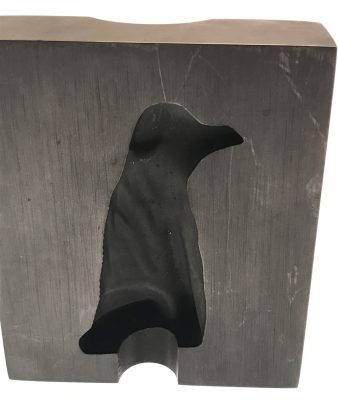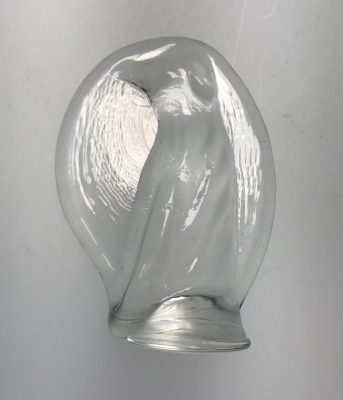Over the past few years, our demonstration teams have made a concerted effort to create new demonstrations that support our featured exhibitions and help our guests gain a deeper understanding of the artisan’s perspective. This typically involves our glassworkers trying to recreate an object or technique that is represented in our changing exhibitions. The exhibition Glass of the Architects: Vienna, 1900–1939, a cooperation of the MAK and LE STANZE DEL VETRO, presented a good jumping off point for a conversation about which our guests are often curious. On many occasions, as we step out of the flameworking demonstration booth, guests will ask us if the object we just hand-crafted could have been produced by a machine, or if the object could have been mass-produced somehow.
As we first began developing a demonstration to support Glass of the Architects, it occurred to us that this contrast between individually hand-crafted objects and those that are made by machine or mass-produced could make for a compelling demonstration. Then, I was struck by a quote from a 1905 exhibition card in which two of the designers and architects represented in the exhibition, Josef Hoffmann and Kolomon Moser, stated, “The limitless harm done to the arts and crafts field by low-quality mass production on the one hand and the unthinking imitation of old styles on the other is affecting the whole world like some gigantic flood … It would be madness to swim against this tide. Nevertheless, we have founded the [Wiener Werkstätte (Vienna workshop)].” This cemented the idea for the demo as we realized just how concerned some of the designers represented in the exhibition were with the results of mass-production.
In order for a machine to emulate a hand-sculpted object on the flameworking torch, it would require pressing molten glass into a mold. To demonstrate this, the flameworking team had a graphite mold of a dog fabricated. To begin the demonstration, we heat a gather of glass and quickly press it into the mold with a graphite paddle. What quickly emerges is a static sculpture of two-thirds of a dog in a rigid, seated posture.
- Our graphite mold of a dog.
- This is the glass dog that our mold produces.
The details are very simple, and they have to be. There are some important limitations to what can be accomplished with a mold of this sort. We need to be able to get the glass to fill all the details of the mold before it cools and is too stiff to flow. That is why our molded dog is in a compressed, seated posture. If the mold was of a dog with separated legs or in a standing posture, it would be nearly impossible to get the molten glass into such tight spaces before it hardened. The mold also needs to be designed so that when the glass hardens, it can still be removed from the mold. To accomplish this, there cannot be any areas in which the glass can get under the graphite of the mold; otherwise, we would never get the object out of the mold without breaking either the glass or the mold itself.
Many of the artists, designers, and architects who we reference in Glass of the Architects were greatly concerned that the mass-production of housewares and decorative objects was limiting the quality of objects and their design. While there are limitations to what glass objects can be made by mold or machine processes, there are also some great benefits. During the demonstration, we like to point out some of the amazing capabilities that machined and mass-produced glass have afforded us. Many of these objects and processes are well represented in our Innovation Center.
The Owens Bottle Machine, for example, came into use in 1903 and could make more bottles in an hour than an entire team of glassblowers could make in a full day. This made glass bottles more affordable and allowed for them to be widely available. Our Windows Gallery in the Innovation Center also celebrates advancements that have been made in the mass-production of flat glass for windows. Imagine a world in which windows were too expensive to have in all our homes, schools, and businesses: like the Owens Bottle Machine, many of the advancements depicted in the gallery also made windows more affordable and accessible to the general public.
Going back to our dog, after the completion of the molded dog, our flameworkers then proceed to hand-sculpt a glass dog to highlight some of the differences between hand-crafted and molded glass. We take this time to discuss some of our motivations as artists and how we can add deeper meanings to objects through considering why we choose to make an object and the methods we used to make it.
Our audiences have been very receptive to this new demonstration as it opens some engaging conversations, and our staff are really enjoying sharing this level of information with our guests. We find guests looking a bit closer at the exhibitions we have in the Innovation Center that discuss machine processes, and we see this as a great conversation starter as our guests experience the Glass of the Architects exhibition.
The Artisan’s Hand demonstration is performed every day at 2:20 pm at our Flameworking Demonstration booth in the Innovation Center. We hope you will enjoy the demo, and that it helps you more deeply consider the influence of the artisan’s hand in the objects you see throughout The Corning Museum of Glass and beyond.
 Glass of the Architects, Vienna: 1900–1937, a cooperation of the MAK and LE STANZE DEL VETRO, is on view at The Corning Museum of Glass through January 7, 2019. Learn more about the exhibition.
Glass of the Architects, Vienna: 1900–1937, a cooperation of the MAK and LE STANZE DEL VETRO, is on view at The Corning Museum of Glass through January 7, 2019. Learn more about the exhibition.





